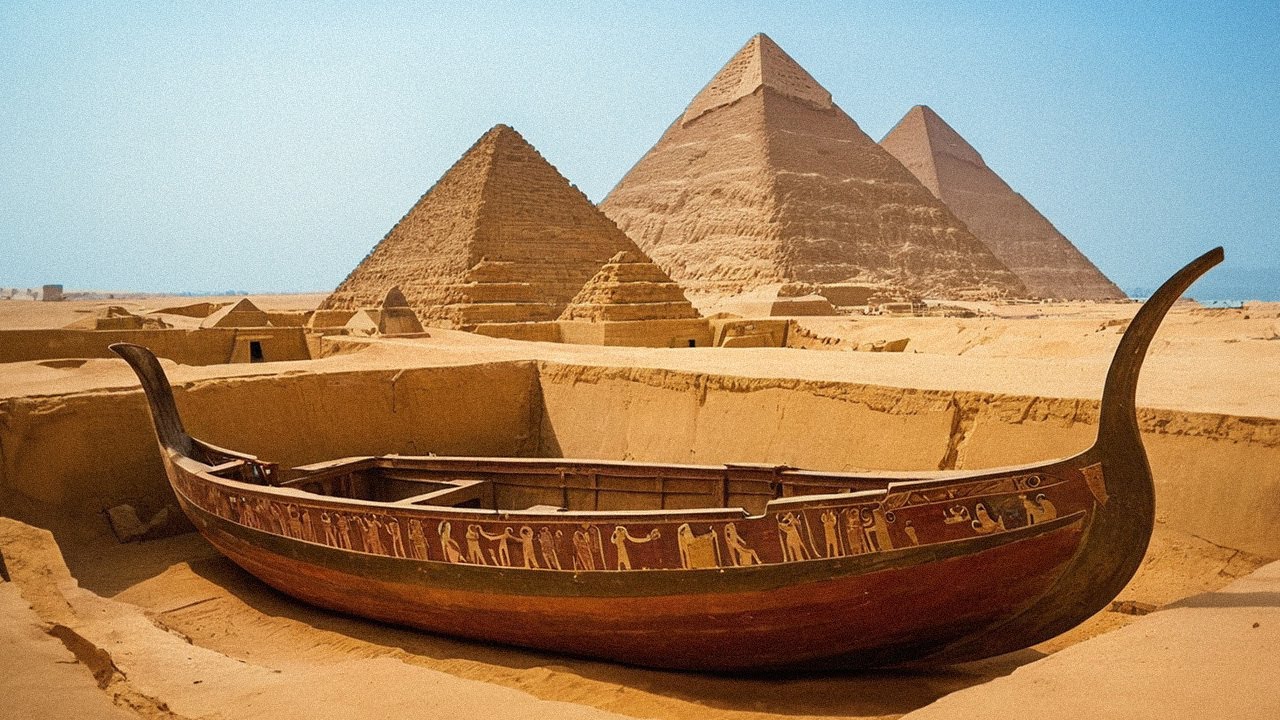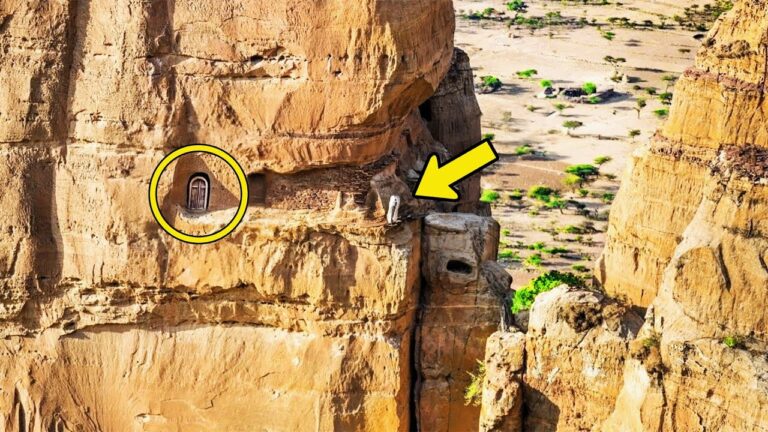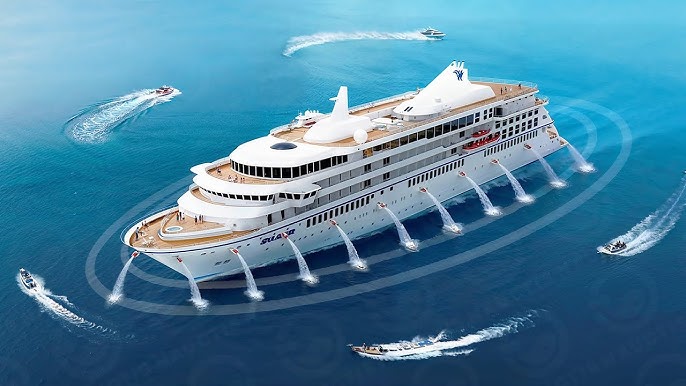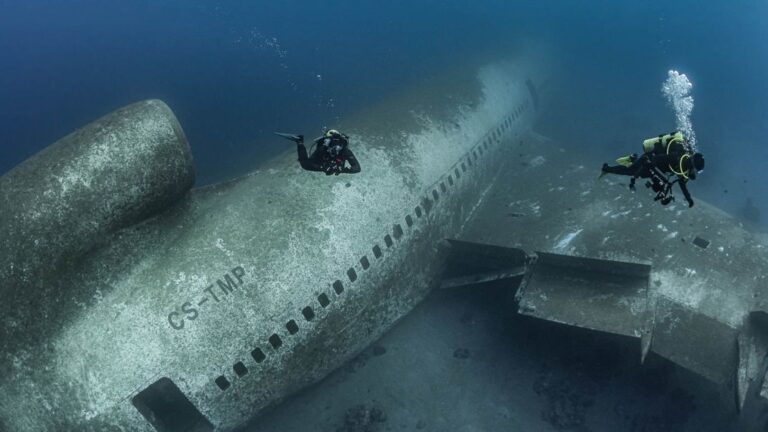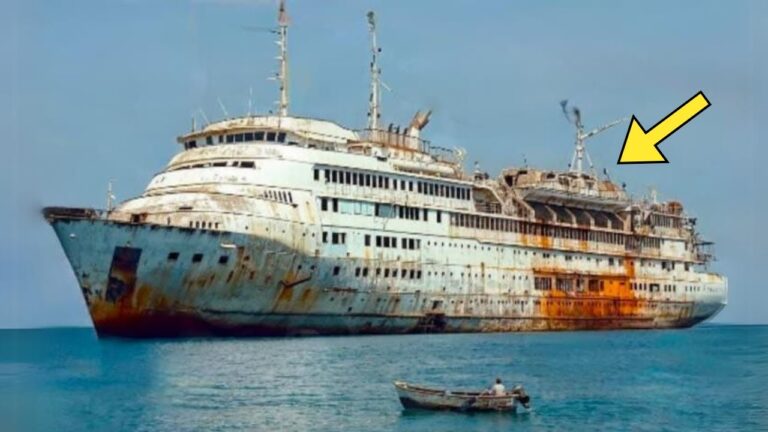In the vast, arid expanse of Egypt’s desert lies a mystery that has puzzled archaeologists for decades. Imagine a scene where a storm, rare in these lands, reveals an ancient structure buried deep in the sand. As the wind whips across the desert, an unexpected shape emerges—a wooden vessel, eroded and hollowed by centuries of termites, but still intact enough to be recognized as something significant. This discovery, made in 1988, was only the beginning of an archaeological puzzle that would take years to solve and would ultimately unveil one of the most remarkable finds in Egyptology. It would reveal a fleet of 14 ancient boats, hidden for over 5,000 years, in the middle of a desert far from any water.
These boats, far from being abandoned relics, were actually part of a larger, grand ceremonial structure, symbolizing much more than mere transportation. They would reveal insights into ancient Egyptian maritime history, religious beliefs, and funerary practices. This blog will take a deep dive into the story of these ancient boats, exploring their discovery, their purpose, and the legacy they left behind, as well as related finds that continue to shape our understanding of one of the world’s oldest civilizations.
The Discovery: Boats in the Desert
In 1988, an unusual event occurred near Abydos, one of Egypt’s most significant ancient archaeological sites. A storm uncovered a strange structure beneath the sand, its weathered wood poking through the dunes. Termites had hollowed out the vessel, leaving behind a relic that intrigued researchers. It wasn’t long before archaeologists realized that this wasn’t just any wooden object—it was part of something much larger.
The real breakthrough came in the year 2000 when a team of American archaeologists began digging at the site. What they uncovered was astounding: a fleet of 14 large wooden boats, carefully arranged and remarkably well-preserved despite being buried for over five millennia. These boats, measuring an impressive 70 feet in length, were not merely symbolic or decorative objects. They were real, full-sized vessels, each capable of carrying up to 30 rowers. They weren’t models or representations but functioning boats—though the question remained: had they ever sailed upon the waters of ancient Egypt?
While it was impossible to completely excavate and preserve the boats in their entirety, the condition of the wood was good enough for detailed analysis. These boats were determined to be over 5,000 years old, predating the Great Pyramids of Giza by nearly half a millennium. The discovery of this fleet marked the earliest known examples of large, built boats in human history—an extraordinary milestone in shipbuilding.
The Significance of the Boats: Ancient Egyptian Shipbuilding
The boats found at Abydos were not the primitive dugout canoes that one might expect from such an ancient time. Rather, they were constructed using a technique known as “built boats.” This method involved stitching planks of wood together, a significant advancement over the more common practice of hollowing out large tree trunks or weaving reeds into rafts. The boats at Abydos, therefore, represent a major breakthrough in ancient Egyptian shipbuilding and their ability to transport both goods and people along the Nile and beyond.
In fact, the construction of these boats was a testament to the sophistication of early Egyptian maritime technology. These vessels required skilled craftsmanship and an understanding of engineering that would later be reflected in the much larger and more complex ships used in Egypt’s imperial era. The boats at Abydos were designed to last, made from wood that had to be imported from distant lands such as Lebanon, as there was no indigenous cedar in Egypt’s deserts. This adds another layer to the mystery: only a Pharaoh would have had the resources and wealth to afford such luxurious timber for the construction of these boats.
The boats’ remarkable preservation has provided archaeologists with unprecedented insights into the ancient world of Egypt. They are the oldest surviving examples of seafaring vessels, and studying them has allowed researchers to better understand the shipbuilding techniques of the time, which would influence later Egyptian designs.
The Location: Why the Boats Were in the Desert
One of the most perplexing aspects of the discovery was the location of the boats. Abydos is located far from the Nile River, and the boats were buried in the desert, far from any water. This raised an immediate question: why would such an impressive fleet of vessels be placed in such a seemingly illogical location?
Initially, archaeologists had assumed that the boats had been stored near the river, perhaps even docked on a bank. However, further investigation revealed that the course of the Nile had long shifted. Today, the river is located around seven miles to the west of Abydos, meaning that the boats couldn’t have been placed there for practical purposes, such as transportation. This led researchers to abandon their initial theories and consider alternative explanations.
The arrangement of the boats also seemed deliberate. Each of the 14 boats was carefully positioned in parallel lines, placed inside chambers that matched their dimensions. These chambers were built from mud bricks, with walls covered in over 120 depictions of boats—suggesting a highly symbolic purpose for the boats’ placement.
The boats, it turned out, were not meant for practical use at all. Rather, they were part of an elaborate funerary complex designed to ensure the Pharaoh’s safe journey to the afterlife. This was a ceremonial setting, not a functional dock, and it reflected the ancient Egyptians’ deep spiritual beliefs regarding death and the afterlife.
The Pharaoh’s Journey: Religious and Symbolic Significance
The ancient Egyptians believed that the Pharaoh was not merely a mortal king, but a divine figure, the earthly incarnation of the Sun god Ra. Ra was thought to travel across the sky each day in a solar boat, and at night, he would sail through the underworld in a boat, battling the forces of chaos to ensure the Sun would rise again. This journey of Ra was central to Egyptian cosmology, and the Pharaoh was seen as taking on the role of Ra, especially after death. The boats, therefore, were not just transport vessels—they were sacred objects needed to carry the Pharaoh through the afterlife, ensuring his rebirth and eternal life.
This symbolic connection to Ra explains why boats were so crucial in funerary rituals. The Pharaoh needed a fleet of boats to accompany him on his journey through the underworld, where he would face various trials before reaching the afterlife. The Egyptians believed that the Pharaoh’s journey through the underworld was a perilous one, and the boats were meant to help him navigate this challenging terrain, much like the boats used by Ra to travel across the sky and through the underworld.
Thus, the boats at Abydos were not just royal symbols or funerary items; they were vital tools for the Pharaoh’s regeneration in the afterlife, ensuring his immortality and eternal rule. Their importance is underscored by the elaborate vaults in which they were stored—vaults that mirrored the tombs of the Pharaohs, designed to protect and preserve the sacred objects that would accompany him on his journey.
The Pharaoh Behind the Boats: King Senusret III
Archaeologists have long speculated about which Pharaoh may have been responsible for the fleet of boats discovered at Abydos. After much investigation, the most likely candidate appears to be King Senusret III, a ruler of Egypt’s Fifth Dynasty. His tomb, located just a mile from the site of the boat fleet, suggests that this was a funerary complex dedicated to him.
Senusret III was one of Egypt’s most powerful and influential Pharaohs, known for his military campaigns, as well as his religious and architectural contributions. The timing and style of the boat chambers align with his reign, and the boat fleet’s location near his tomb suggests that they were part of a grand ceremonial procession for his burial. The boats would have played a critical role in transporting the Pharaoh’s body along the Nile to its final resting place at Abydos, and their burial in the desert symbolized his passage to the afterlife.
This theory is further supported by ancient Egyptian burial customs, which often involved the inclusion of ceremonial items, such as boats, that would accompany the Pharaoh in death. These items were meant to ensure that the Pharaoh’s journey through the afterlife was successful and that he would continue to rule in the spiritual realm.
The Legacy of Abydos: Unraveling Ancient Egyptian Mysteries
The discovery of the boat fleet at Abydos has had a profound impact on our understanding of ancient Egyptian culture. It has provided valuable insights into Egyptian shipbuilding techniques, religious beliefs, and funerary practices. It has also highlighted the importance of the Pharaoh in Egyptian society, both as a divine ruler and as a central figure in the country’s religious cosmology.
But the mystery of the boats at Abydos is just one piece of the puzzle. Over the years, numerous other discoveries have been made in Egypt that continue to shed light on the ancient world. For example, the discovery of the tomb of Tutankhamun in 1922 revealed a wealth of treasures and artifacts, some of which were also related to the Pharaoh’s journey in the afterlife. Similarly, the discovery of a lost “golden city” in 2020 has provided new insights into daily life during Egypt’s wealthiest period.
Perhaps most intriguing is the fact that Egypt’s rich archaeological landscape is still full of hidden treasures. The boats of Abydos, along with other discoveries, challenge our understanding of the ancient world and show that there is still so much to learn about this fascinating civilization.
Conclusion: A Civilization That Continues to Fascinate
The fleet of boats found at Abydos serves as a testament to the ancient Egyptians’ remarkable ingenuity, religious devotion, and artistic craftsmanship. These boats were not just utilitarian vessels—they were sacred objects imbued with deep spiritual significance. As we continue to unravel the mysteries of ancient Egypt, these boats will forever remain a symbol of the culture’s profound connection to the divine and their belief in life after death.
Egypt’s history is a story of triumphs, discoveries, and mysteries that continue to captivate the world. The boats at Abydos are just one chapter in that long, fascinating narrative, and they remind us of the incredible legacy left behind by one of the world’s oldest civilizations. As more discoveries are made, we are given an ever-deeper understanding of a culture that continues to influence and inspire us to this day.

